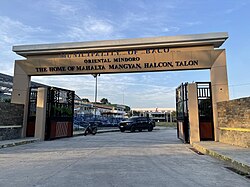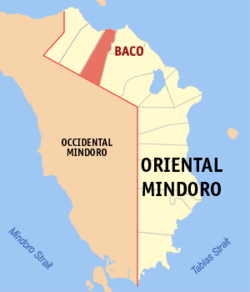Municipality of Baco | |
|---|---|
 Municipal Compound Gate | |
 Map of Oriental Mindoro with Baco highlighted | |
 Interactive map of Municipality of Baco | |
Location within the Philippines | |
| Coordinates: 13°21′30″N121°05′52″E / 13.358394°N 121.097664°E | |
| Country | Philippines |
| Region | Mimaropa |
| Province | Oriental Mindoro |
| District | 1st district |
| Barangays | 27 (see Barangays) |
| Government | |
| • Type | Sangguniang Bayan |
| • Mayor | Allan "AR" A. Roldan |
| • Vice Mayor | Brederick "Eric" V. Castillo |
| • Representative | Arnan Panaligan |
| • Sangguniang Bayan | Members |
| • Electorate | 26,166 voters (2025) |
| Area | |
• Total | 216.23 km2 (83.49 sq mi) |
| Elevation | 20 m (66 ft) |
| Highest elevation | 480 m (1,570 ft) |
| Lowest elevation | 0 m (0 ft) |
| Population (2024 census) [3] | |
• Total | 40,159 |
| • Density | 185.72/km2 (481.02/sq mi) |
| • Households | 9,182 |
| Demonym(s) | Bacoeño (Male) Bacoeña (Female) |
| Economy | |
| • Income class | 3rd municipal income class |
| • Poverty incidence | 34.45 |
| • Revenue | ₱ 228.4 million (2022) |
| • Assets | ₱ 379.5 million (2022) |
| • Expenditure | ₱ 185.2 million (2022) |
| • Liabilities | ₱ 25.87 million (2022) |
| Service provider | |
| • Electricity | Oriental Mindoro Electric Cooperative (ORMECO) |
| Time zone | UTC+8 (PST) |
| ZIP code | 5201 |
| PSGC | |
| IDD : area code | +63 (0)43 |
| Native languages | Tagalog |
Baco, officially the Municipality of Baco (Tagalog : Bayan ng Baco), is a municipality in the province of Oriental Mindoro, Philippines. According to the 2024 census, it has a population of 40,159 people. [5]
Contents
- Etymology
- History
- Folktales
- First Capital of Oriental Mindoro
- Spanish Colonization
- Spanish Revolution
- Foundation Day
- Geography
- Topography
- Elevation
- Slope
- Tourism
- Barangays
- Climate
- Demographics
- Economy
- Education
- Primary and elementary schools
- Secondary schools
- Higher educational institutions
- References
- External links


